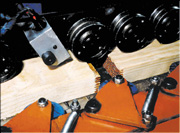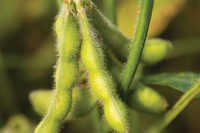
The soy-based product provides exceptional performance with environmental and worker benefits. The wood adhesive is made from traditional phenol-resorcinol-formaldehyde resin and an additional soy-based adhesive. The product, PRF/Soy 2000, was developed with soybean checkoff funding from the United Soybean Board (USB), Chesterfield, Mo.
“Adhesives for wood have played an important role in the forest products industry, and this role is growing in importance,” said Chuck Grabiel, commercialization manager at Omni Tech International and technical consultant for USB. “The demonstrated performance of the PRF/Soy 2000 as a durable, exterior-grade glue has dispelled much of the doubt that a natural product can compete with petroleum-based products.”
PRF/Soy 2000 is used in a two-step application. The PRF resin is applied to one end of a piece of finger-joint lumber. The soy adhesive is applied to another piece. When these two compounds are joined, a bond forms within seconds that provides greater strength than the natural wood itself. This allows scrap pieces of wood to be turned into strong, usable lumber. In fact, the Western Wood Products Association, Portland, Ore., has approved PRF/Soy 2000 for use in vertical and horizontal structures.
The fact that the adhesive system is the only product on the market that has the ability to finger-joint green lumber provides an enormous economic benefit to the lumber industry. The soy-based product can also be cleaned up with soap and water, cutting down on time and chemicals needed to properly clean equipment.
By replacing part of the phenol-resorcinol-formaldehyde used in traditional finger-jointing applications with a soy-based adhesive, VOCs and offensive odors are reduced. This is beneficial for both the environment and mill workers.
The United Soybean Board, composed of 62 U.S. soybean farmers, oversees soybean checkoff-funded investments in foreign market development, human and animal health and nutrition, research and development of new uses, and agronomic research in soybeans.
For more information on PRF/Soy 2000 soy-based adhesives, contact the United Soybean Board, 16640 Chesterfield Grove Road, Suite 130, Chesterfield, MO 63005-1429; call 888-235-4332; or visit the Web site www.unitedsoybean.org.
